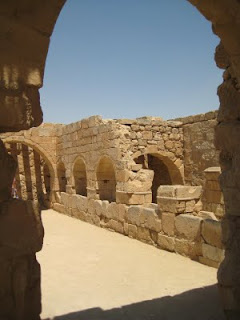
In the Sixth Century BCE the Nabateans, a nomadic people group, began to settle in southern Jordan, the Negev region of Israel and northern Arabia. Their capitol was Petra, earlier inhabited by the Edomites; it was the Nabateans who carved the structures into the sandstone remaining today.
The Nabateans were able to establish a trading network stretching from China, India and the Far East to western areas including Egypt, Syria, Greece and Rome. The trading routes dealt with goods including spices, incense, perfumes, fabrics and other commercial goods. This trading network was the source of power for the Nabatean Empire.
Mampsis (Mamshit), located deep in the Negev Desert, is one location built by the Nabateans. Not only were the Nabateans able to survive in this harsh location, they were ale to thrive.
Mampsis was built during the first century CE during the late Nabatean period, and was located along one of the most important branches of the Incense Route. Mampsis even appeared in the ancient mosaic floor of Madaba, Jordan, depicting Israel during the Byzantine period (4th-7th Century CE).
Mampsis was later used by the Romans after the Nabatean kingdom was annexed to Rome. Additions were made during this time, including the building of two churches. The site ceased to exist after the Persian invasion in 614 CE.
Water is important in the dry region of the Negev. The Nabateans were the only people who knew the secrets of the desert, making them the only people group able to cross the Arabian Desert. These secrets helped them maintain their monopoly on the spice trade. These secrets also helped them survive in the harsh deserts of the Middle East. Their secret to survival at Mampsis was to collect rainwater and brought it into the city through a channel system, build dams along the Mampsis stream and plaster their cisterns to preserve their water.
Mampsis is another example of the ingenuity of people living in southern Israel.
I enjoyed visiting the location, and hope the pictures highlight the sites at Mampsis!

The Marketplace in Mampsis. Both sides of the street have rooms serving as shops.

The Byzantine Bathhouse at Mampsis. This structure contained three rooms: a hot room, a tepid room and a dressing and furnace room. Similar to Masada, clay pipes along the walls allowed hot air to travel to the rooms from a furnice room below the structure.


The "Church of the Martyrs."

No comments:
Post a Comment